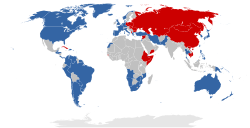
Back Модел на трите свята Bulgarian 3つの世界モデル Japanese 3개의 세계 모델 Korean Trīs Pasauļu modelis Latvian/Lettish Teoria dos Mundos Portuguese Модел три света Serbian Mô hình Tam thế giới Vietnamese 三个世界模式 Chinese

First World: Countries aligned with the Western Bloc (i.e., NATO and allies), led by the United States
Second World: Countries aligned with the Eastern Bloc (i.e., Warsaw Pact, China, and allies), led by the Soviet Union
The terms First World, Second World, and Third World were originally used to divide the world's nations into three categories. The complete overthrow of the pre–World War II status quo left two superpowers (the United States and the Soviet Union) vying for ultimate global supremacy, a struggle known as the Cold War. They created two camps, known as blocs. These blocs formed the basis of the concepts of the First and Second Worlds.[1] The Third World consisted of those countries that were not closely aligned with either bloc.
- ^ Gaddis, John (1998). We Now Know: Rethinking Cold War History. Oxford: Oxford University Press. pp. 1–2. ISBN 0-19-878071-0.